Mobocertinib
Editor-In-Chief: C. Michael Gibson, M.S., M.D. [1]; Associate Editor(s)-in-Chief: Tejasvi Aryaputra
Disclaimer
WikiDoc MAKES NO GUARANTEE OF VALIDITY. WikiDoc is not a professional health care provider, nor is it a suitable replacement for a licensed healthcare provider. WikiDoc is intended to be an educational tool, not a tool for any form of healthcare delivery. The educational content on WikiDoc drug pages is based upon the FDA package insert, National Library of Medicine content and practice guidelines / consensus statements. WikiDoc does not promote the administration of any medication or device that is not consistent with its labeling. Please read our full disclaimer here.
Black Box Warning
|
QTC PROLONGATION AND TORSADES DE POINTES
See full prescribing information for complete Boxed Warning.
|
Overview
Mobocertinib is a kinase inhibitor that is FDA approved for the treatment of locally advanced or metastatic non-small cell lung cancer with epidermal growth factor receptor exon 20 insertion mutations.. There is a Black Box Warning for this drug as shown here. Common adverse reactions include nausea, vomiting, fatigue, musculoskeletal pain, paronychia, diarrhea, dry skin, stomatitis, rash, and a decrease in appetite.
Adult Indications and Dosage
FDA-Labeled Indications and Dosage (Adult)
- 160 mg with or without food, once daily at the same time each day.
Off-Label Use and Dosage (Adult)
Guideline-Supported Use
There is limited information regarding Off-Label Guideline-Supported Use of Mobocertinib in adult patients.
Non–Guideline-Supported Use
There is limited information regarding Off-Label Non–Guideline-Supported Use of Mobocertinib in adult patients.
Pediatric Indications and Dosage
FDA-Labeled Indications and Dosage (Pediatric)
There is limited information regarding Mobocertinib FDA-Labeled Indications and Dosage (Pediatric) in the drug label.
Off-Label Use and Dosage (Pediatric)
Guideline-Supported Use
There is limited information regarding Off-Label Guideline-Supported Use of Mobocertinib in pediatric patients.
Non–Guideline-Supported Use
There is limited information regarding Off-Label Non–Guideline-Supported Use of Mobocertinib in pediatric patients.
Contraindications
There are no contraindications associated with Mobocertinib
Warnings
|
QTC PROLONGATION AND TORSADES DE POINTES
See full prescribing information for complete Boxed Warning.
|
QTc Prolongation and Torsades de Pointes
- Torsades de Pointes and life-threatening heart rate-corrected QT can be caused when taking Mobocertinib.
- A QTc interval greater than 500 msec was found in 1.2% of patients in a study of a 250 patient subset who had scheduled and unscheduled ECGs. The patients in the subset were part of a pooled Mobocertinib safety population.
- A change-from-baseline QTc greater than 60 msec was found in 11% of patients in a study of a 250 patient subset who had scheduled and unscheduled ECGs. The patients in the subset were part of a pooled Mobocertinib safety population.
- 0.4% of patients experienced Grade 4 Torsades de Pointes in a study of a 250 patient subset who had scheduled and unscheduled ECGs. The patients in the subset were part of a pooled Mobocertinib safety population.
- Potassium, calcium, sodium, and magnesium abnormalities should be corrected prior to taking Mobocertinib.
- Both electrolytes at baseline and QTc at baseline should be assessed prior to taking Mobocertinib.
- Monitor electrolytes and QTc during treatment periodically.
- Increase monitoring of patients that have risk factors for QTc prolongation.
- Concomitant use of drugs known to prolong the QTc interval should be avoided.
- Concomitant use of Mobocertinib and moderate or strong CYP3A inhibitors should be avoided.
- Advise patients that QTc prolongation severity can cause Mobocertinib treatment to either be withheld, reduced, or permanently discontinued.
Interstitial Lung Disease (ILD)/Pneumonitis
- ILD/pneumonitis can be caused when taking Mobocertinib.
- 4.3% of patients of the pooled Mobocertinib safety population experienced ILD/pneumonitis. Of the 4.3% patients, 0.8% experienced Grade 3 events while 1.2% experienced events that were fatal.
- Monitor patients for any new pulmonary symptoms or worsening pulmonary symptoms that could potentially be indicative of ILD/pneumonitis.
- Advise patients that suspected ILD/pneumonitis in patients should withhold Mobocertinib treatment.
- Advise patients that confirmed ILD/pneumonitis in patients should permanently discontinue Mobocertinib treatment.
Cardiac Toxicity
- Cardiac toxicity that can lead to fatal heart failure can be caused when taking Mobocertinib.
- 2.7% of patients of the pooled Mobocertinib safety population experienced heart failure. Of the 2.7% patients, 1.2% of patients experienced Grade 3 reactions, 0.4% of patients experienced Grade 4 reactions, and 0.4% of patients experienced a fatal case of heart failure.
- Patients receiving Mobocertinib also experienced left bundle branch block (0.4%), ventricular extrasystoles (0.4%), ventricular tachycardia (0.4%), supraventricular extrasystoles (0.4%), Atrial fibrillation (1.6%), first degree atrioventricular block (0.4%), and second degree atrioventricular block (0.4%).
- Monitor patients cardiac function when taking Mobocertinib.
- Monitor patients left ventricular ejection fraction at baseline when taking Mobocertinib.
- Advise patients that cardiac function severity can cause Mobocertinib treatment to either be withheld, reduced, or permanently discontinued.
Diarrhea
- Diarrhea can be caused when taking Mobocertinib.
- 93% of patients of the pooled Mobocertinib safety population experienced diarrhea. Of the 93% patients, 20% of patients experienced Grade 3 symptoms while 0.4% of patients experienced Grade 4 symptoms.
- 5 days is the median time to first onset of diarrhea in patients.
- 3 days is the median time to resolution of diarrhea in the 48% patients who had their diarrhea resolved.
- Advise patients with or without renal impairment that electrolyte imbalance or dehydration could be caused when experiencing diarrhea.
- Advise patients who start experiencing first signs of diarrhea to start using an antidiarrheal agent.
- Advise patients that electrolyte imbalances can cause Mobocertinib treatment to either be withheld, reduced, or permanently discontinued.
Embryo-Fetal Toxicity
- Based on animal data, Mobocertinib potentially can cause harm to females fetus during pregnancy.
- Studies done on rats showed embryolethality at maternal exposures 1.7 times the human exposure based on AUC at one 160 mg dose daily during the period of organogenesis.
- Advise pregnant females about fetal risks when treated with Mobocertinib.
- Advise females of reproductive potential to use effective non hormonal contraception during treatment with Mobocertinib and for at least 1 months after the last dose.
- Advise males with female partners of reproductive potential to use effective contraception during treatment with Mobocertinib and for at least 1 week after the last dose.
Adverse Reactions
Clinical Trials Experience
Clinical Trials Experience
- Because clinical trials are conducted under widely varying conditions and durations of follow up, adverse reaction rates observed in the clinical trials of a drug cannot be directly compared to rates in the clinical trials of another drug and may not reflect the rates observed in practice.
Pooled Safety Population Study
- The adverse reactions of Mobocertinib were looked at in 256 patients receiving one daily dosage of 160 mg Mobocertinib. Of the 256 patients, 114 of the patients had EGFR exon 20 insertion mutation-positive locally advanced, metastatic NSCLC from Study AP32788-15-101, and patients with other solid tumors. Nausea, paronychia, musculoskeletal pain, rash, decreased appetite, dry skin, diarrhea, stomatitis, and vomiting were the most common adverse reactions reported (>20%). Increased amylase, decreased potassium, decreased magnesium, increased lipase, decreased lymphocytes, increased creatinine, and decreased hemoglobin were the most common Grade 3 or 4 laboratory abnormalities reported (≥2%).
Study AP32788-15-101
- A subset of patients that have metastatic NSCLC who received prior platinum-based chemotherapy or EGFR exon 20 insertion mutation-positive locally advanced were used in a study to test the safety of Mobocertinib. The total amount of patients were 114 that received 160 mg once daily dosage of Mobocertinib in this study.
- Patients that were excluded from the study included patients with significant, uncontrolled, active cardiovascular disease, prolonged QTc interval, radiation pneumonitis that required steroid treatment, a history of interstitial lung disease, or drug-related pneumonitis.
- 46% of patients experienced severe reactions when treated with Mobocertinib. Pyrexia, nausea, dyspnea, cardiac failure, acute kidney injury, diarrhea, and pleural effusion were the severe adverse reactions reported in the patient subset.
- 1.8% of patients reported fatal adverse reactions when taking Mobocertinib. Pneumonitis and cardiac failure were some of the fatal adverse reactions experienced by patients.
- 17% of patients had to permanently discontinue treatment with Mobocertinib with diarrhea and nausea being some of the adverse reactions reported leading to permanent discontinuation.
- 51% of patients had interruptions in Mobocertinib dosage with diarrhea, nausea and vomiting being some of the adverse reactions reported leading to dosage interruptions.
- 25% of patients had reductions in Mobocertinib dosage with diarrhea being one of the many adverse reactions reported leading to dosage reductions.
Table 3 shows the Adverse Reactions in patients part of Study AP32788-15-101 who are treated with Mobocertinib.
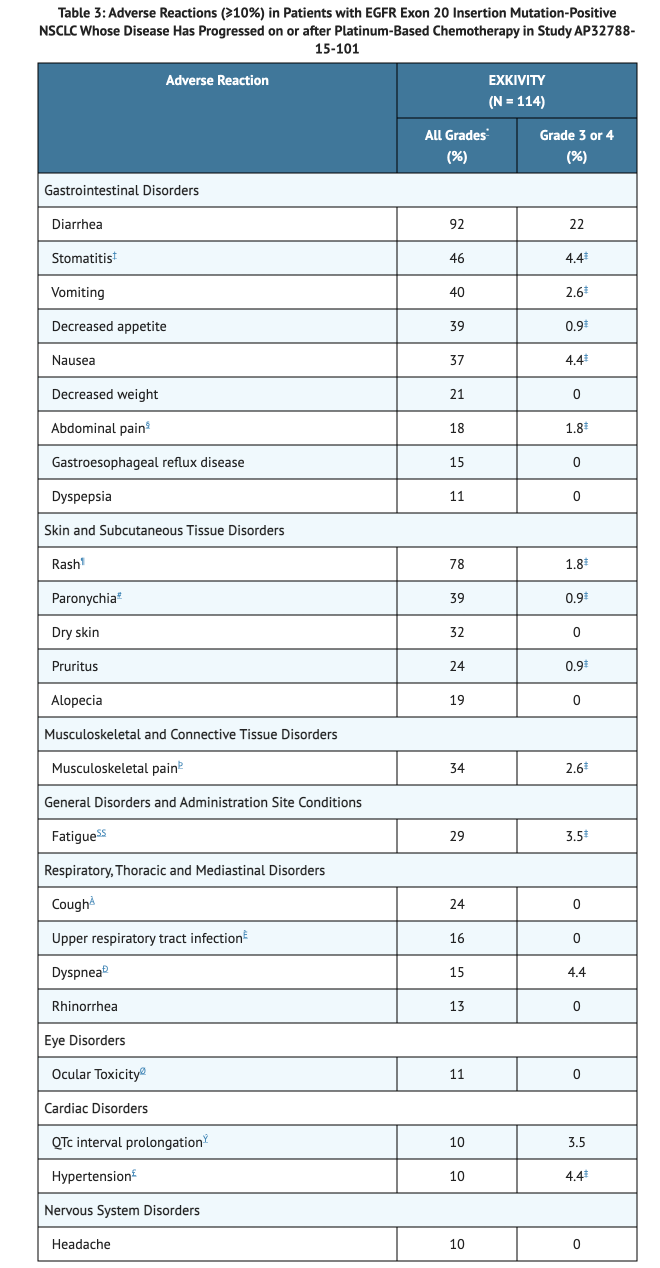
- Peripheral neuropathy, cardiac failure, acute kidney injury, palmar-plantar erythrodysaesthesia, edema, and pneumonitis are clinically relevant adverse reactions reported by patients treated with Mobocertinib.
Table 4 shows the Laboratory Abnormalities in patients part of Study AP32788-15-101 who are treated with Mobocertinib.
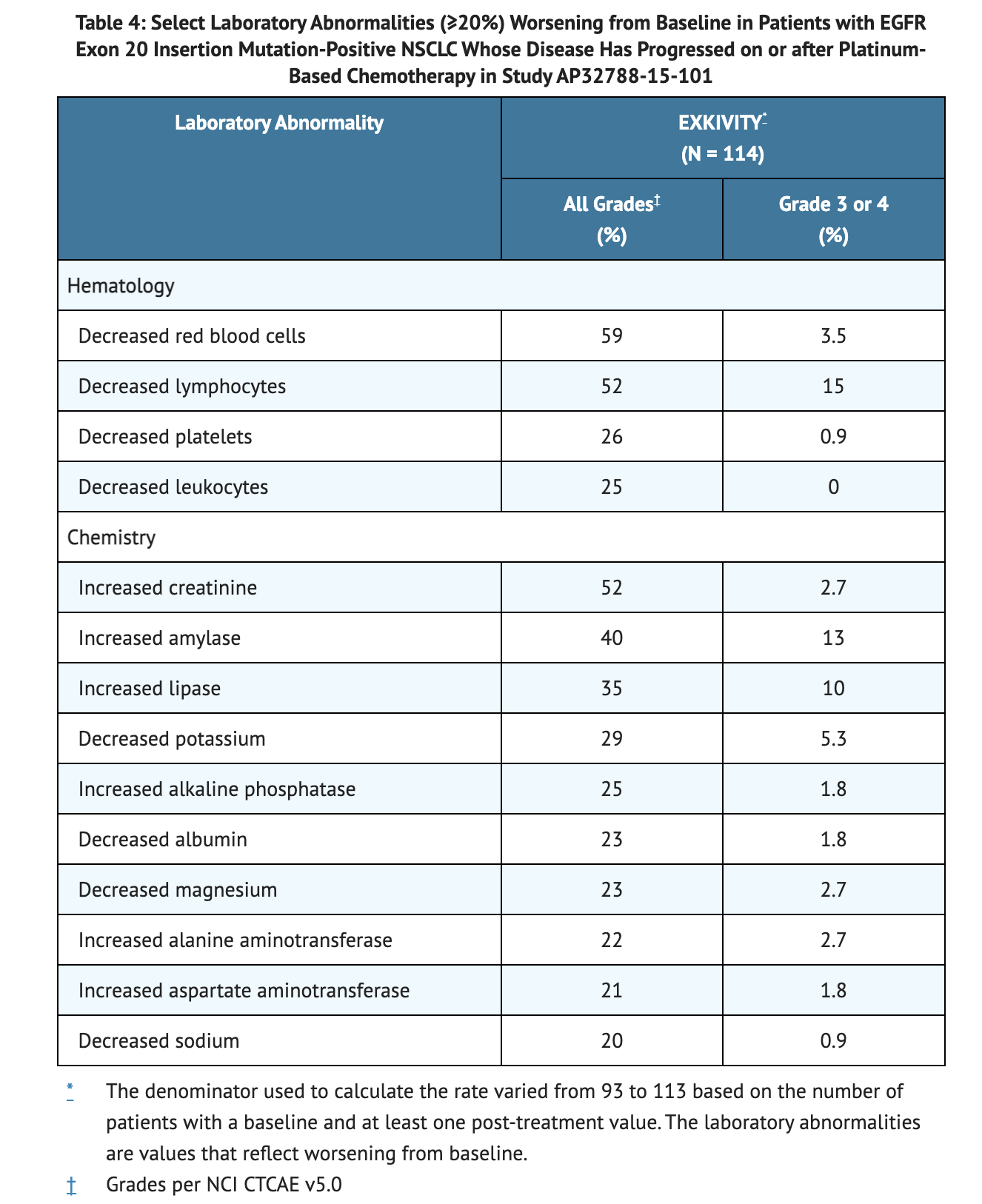
Postmarketing Experience
There is limited information about "Postmarketing Experiance" in the drug label.
Drug Interactions
Effect of Other Drugs on Mobocertinib
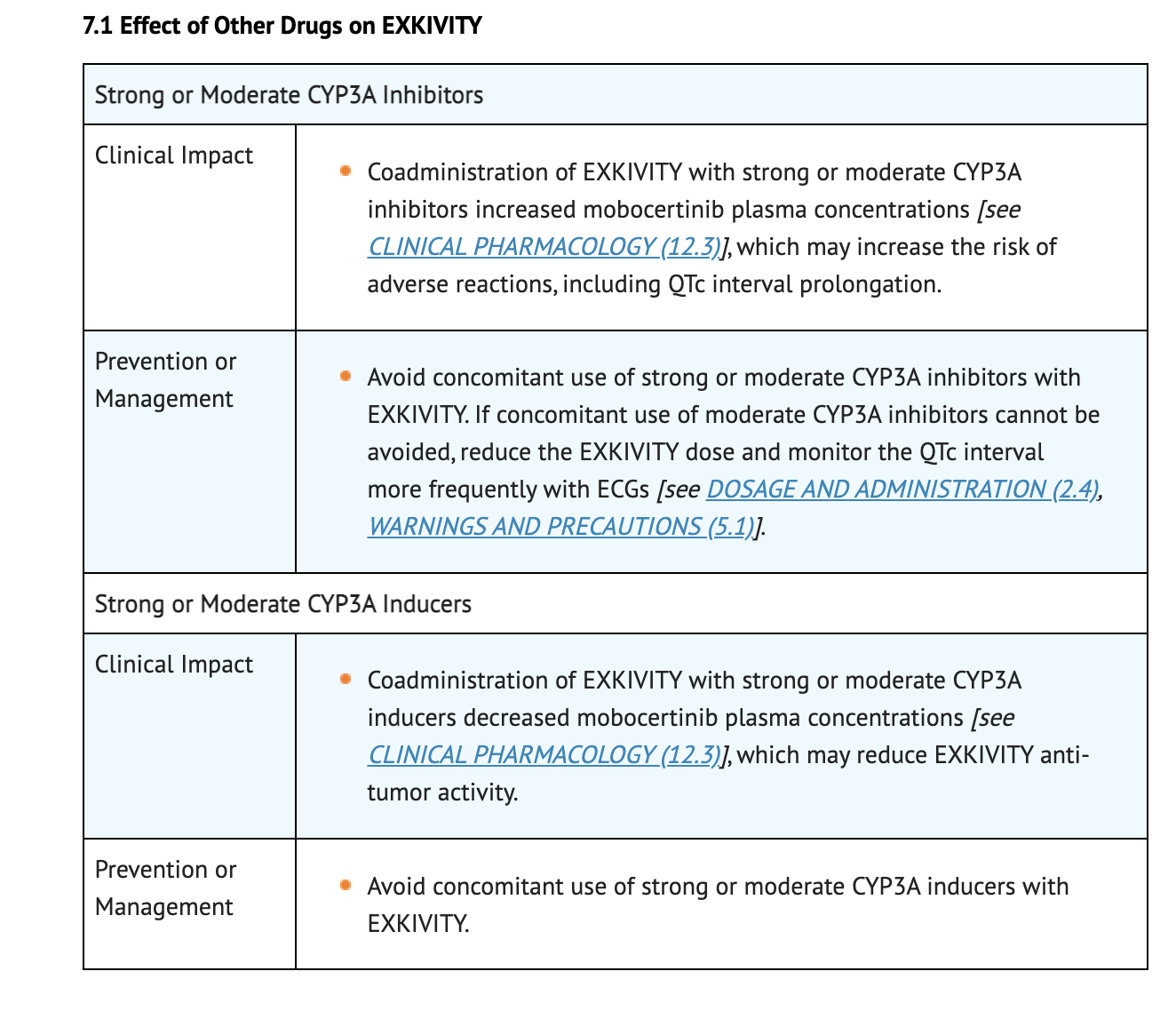
Effect of Mobocertinib on Other Drugs
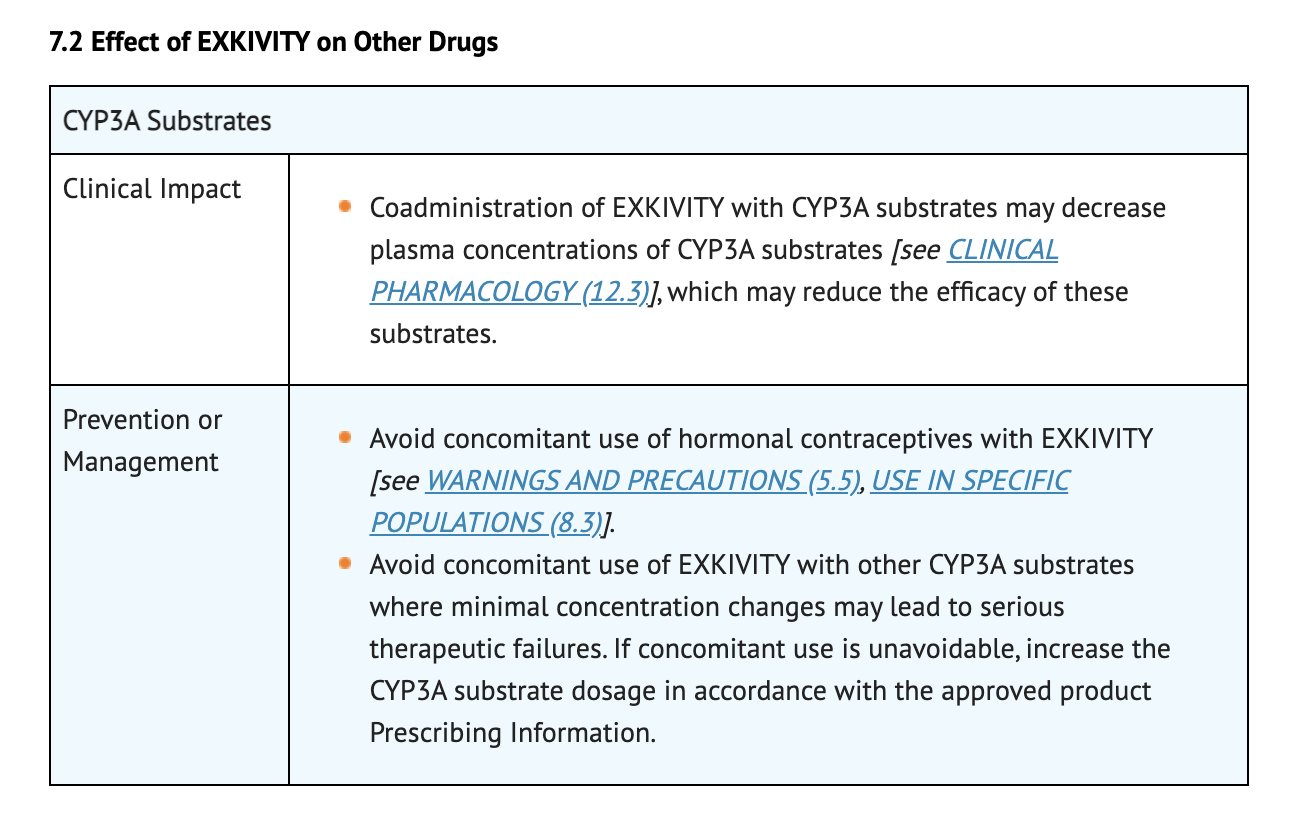
Drugs that Prolong the QTc Interval
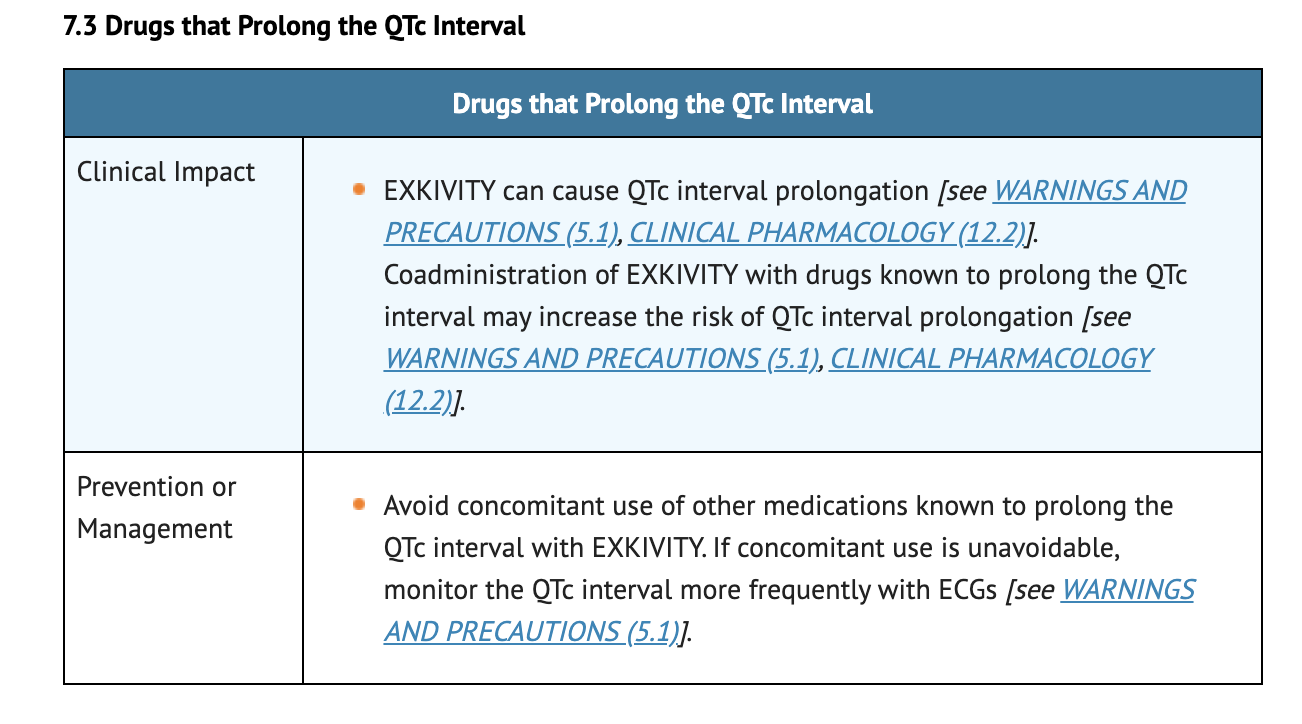
Use in Specific Populations
Pregnancy
Pregnancy Category (FDA):
Studies done on animals show that fetal harm may occur to pregnant women treated with Mobocertinib. Pregnant rat studies show administration of Mobocertinib leads to maternal toxicity at plasma exposures approximately 1.7 times (10 mg/kg) the human exposure based on AUC, and embryolethality during the period of organogenesis. Decreased fetal weight was recorded in pregnant rats, but there were no clear signs at high doses (10 mg/kg) of Mobocertinib that show fetal malformations occurred. Female patients should be advised if pregnant about the potential risks that may occur to the fetus when treated with Mobocertinib.
Pregnancy Category (AUS):
There is no Australian Drug Evaluation Committee (ADEC) guidance on usage of Mobocertinib in women who are pregnant.
Labor and Delivery
There is no FDA guidance on use of Mobocertinib during labor and delivery.
Nursing Mothers
Data on Mobocertinib for its effects on milk production or the effects on the breastfed child have not been found. Advise female patients to not nurse during Mobocertinib treatment, and or 1 week after their last dose of Mobocertinib.
Pediatric Use
Safety and effectiveness in pediatric populations have not been established.
Geriatic Use
Of the total number of subjects (114) in the clinical studies treated with Mobocertinib, around 37% of the patients were 65 years or older in age, and 7% were 75 years or older in age. No differences among young patients compared to patients 65 years or older in age were found when looking at safety and efficacy of Mobocertinib. Higher percentages of Grade 3 and 4 adverse reactions occurred in patients 65 years and older when compared to patients younger than 65 years of age (69% vs 47%) based on exploratory analysis. Higher percentages of serious adverse reactions occurred in patients 65 years and older when compared to patients younger than 65 years of age (64% vs 35%) based on exploratory analysis.
Gender
There is no FDA guidance on the use of Mobocertinib with respect to specific gender populations.
Race
There is no FDA guidance on the use of Mobocertinib with respect to specific racial populations.
Renal Impairment
Mild to moderate renal impairment in patients do not require a dosage adjustment of Mobocertinib. Dosage recommendations of Mobocertinib in patients with severe renal impairment have not been established.
Hepatic Impairment
Mild to moderate hepatic impairment in patients do not require a dosage adjustment of Mobocertinib. Dosage recommendations of Mobocertinib in patients with severe hepatic impairment have not been established.
Females of Reproductive Potential and Males
Advise females of reproductive potential to use effective non hormonal contraception during treatment with Mobocertinib and for at least 1 month after the last dose. Advise males with female partners of reproductive potential to use effective contraception during treatment with Mobocertinib and for at least 1 week after the last dose. Fertility may be impaired in both females and males when treated with Mobocertinib.
Immunocompromised Patients
There is no FDA guidance on the use of Mobocertinib with respect to immunocompromised populations.
Administration and Monitoring
Administration
- Recommended dosage of Mobocertinib as prescribed by the doctor can be taken with or without food.
- Swallow Mobocertinib tablets whole.
- Mobocertinib should be taken at the same time each day.
- Instruct patients to not chew, open, or dissolve contents of the tablets.
- If a dosage of Mobocertinib is missed by more than 6 hours, then skip dosage and take next dosage at scheduled time the next day.
- Do not take extra dosage of Mobocertinib if dosage taken is vomited, just take next dosage at scheduled time the next day.
Monitoring
Dosage Modifications for Moderate CYP3A Inhibitors
- Advise patients to avoid concomitant use of Mobocertinib with a moderate CYP3A inhibitor.
- Reduce Mobocertinib dosage by 50% if concomitant use of a moderate CYP3A inhibitor is unavoidable. Mobocertinib dosage can return to normal amount after the inhibitor is discontinued for 3 to 5 elimination half-lives.
- Monitor patients for QTc interval when concomitant use of a moderate CYP3A inhibitor is unavoidable during Mobocertinib treatment.
Dosage Modifications for Adverse Reactions
Table 1 and 2 show the Reduction in Dosage to Mobocertinib for Patients with Adverse Reactions.

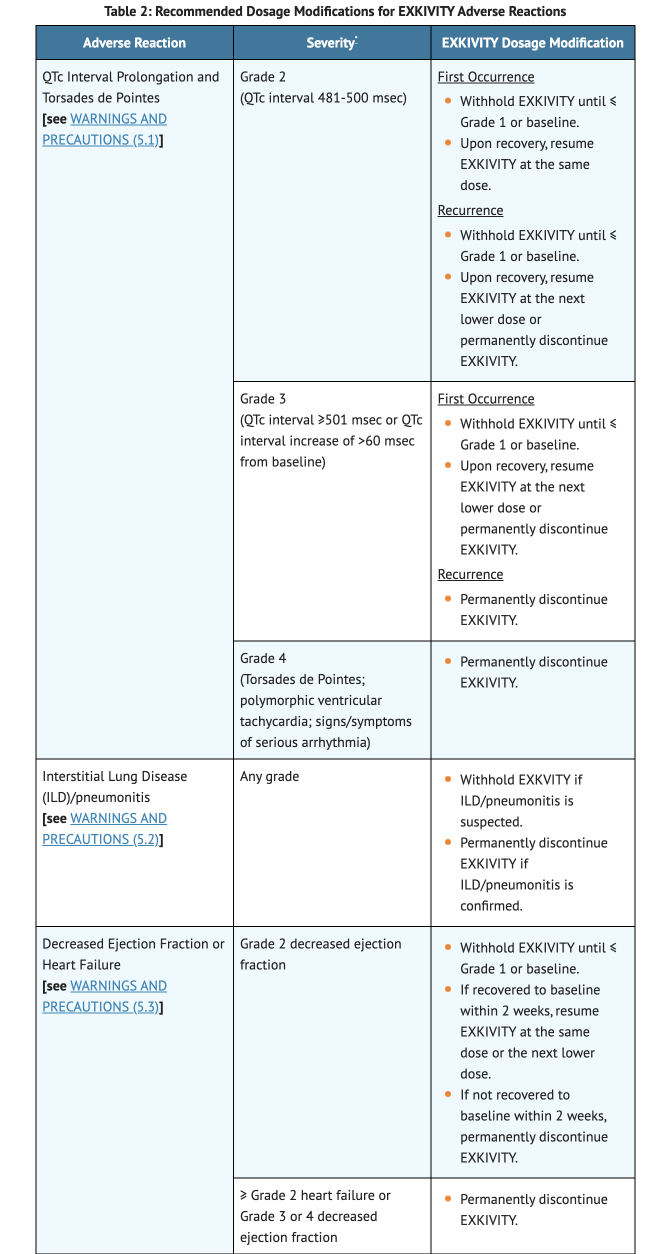
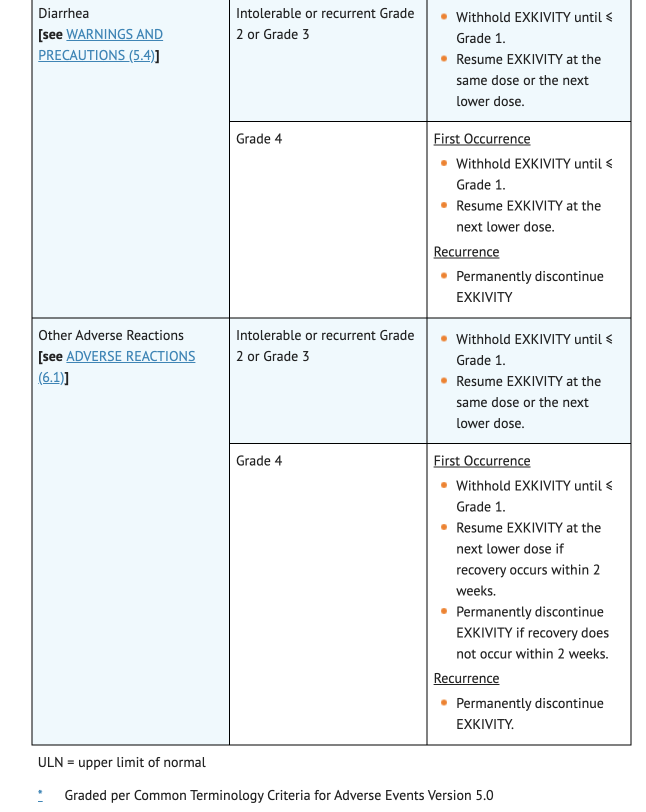
IV Compatibility
There is limited information regarding the compatibility of Mobocertinib and IV administrations.
Overdosage
There is limited information regarding Mobocertinib overdosage. If you suspect drug poisoning or overdose, please contact the National Poison Help hotline (1-800-222-1222) immediately.
Pharmacology
Mechanism of Action
- Mobocertinib is a kinase inhibitor.
- It inhibits EGFR exon 20 insertion mutations at lower concentrations than wild type (WT) EGFR by binding to it.
- In vitro, HER2, BLK and HER4 activity were inhibited by Mobocertinib at clinically relevant concentrations.
- Animal tumor implantation models show anti-tumor activity against xenografts with the EGFR exon 20 insertions NPH or ASV done by Mobocertinib.
- Cultured cell models show proliferation of cells driven by different EGFR exon 20 insertion mutation variants were inhibited by Mobocertinib.
Structure
- Mobocertinib is a kinase inhibitor for oral administration. It has an empirical formula of C46H45N7O8 and a molecular weight of 703.8 g/mol.
- The chemical name is propan-2-yl 2-[5-(acryloylamino)-4-{[2-(dimethylamino)ethyl](methyl)amino}-2-methoxyanilino]-4-(1-methyl-1H-indol-3-yl)pyrimidine-5-carboxylate succinate.
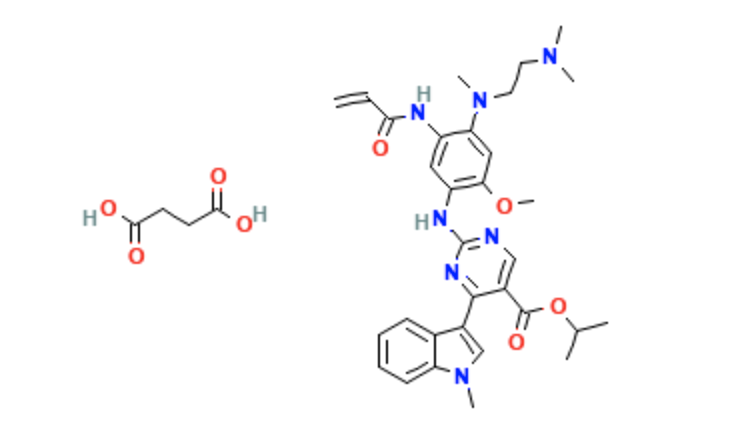
Pharmacodynamics
- Exposure-response relationships and pharmacodynamic response for Mobocertinib are unknown.
Cardiac Electrophysiology
- For one daily dose of 160mg of Mobocertinib, 23.0 msec is the largest mean increase in QTc. 12.4 msec is largest mean increase in the PR interval.
Pharmacokinetics
- Over the range of 5 to 180 mg once daily of Mobocertinib, the combined AUC0-24h and Cmax is dose proportional.
- Over the range of 5 to 180 mg once daily of Mobocertinib, AP32960 and AP32914 (active metabolites) are dose proportional.
Absorption
- For Mobocertinib, 4 hours is the median time to peak concentration.
- 37% is the mean absolute bioavailability for Mobocertinib.
Effect of Food
- In a high-fat meal, combined molar AUC and Cmax had no clinically meaningful differences AP32960, Mobocertinib, and AP32914 when compared to an overnight fast.
- In a low-fat meal, combined molar AUC and Cmax had no clinically meaningful differences AP32960, Mobocertinib, and AP32914 when compared to an overnight fast.
Distribution
- In vitro, 99.3% is the mean bound fraction for Mobocertinib.
- In vitro, 99.5% is the mean bound fraction for AP32960.
- In vitro, 98.6% is the mean bound fraction for AP32914.
- 0.76 is the blood-to-plasma ratio for Mobocertinib.
- 1.2 is the blood-to-plasma ratio for AP32960.
- 0.71 is the blood-to-plasma ratio for AP32914.
- 3,509 L is the mean apparent volume of distribution for Mobocertinib at steady-state.
Elimination
- 18 hours is the mean plasma elimination half-life at steady state for Mobocertinib.
- 138 L/hr is the mean apparent oral clearance at steady state for Mobocertinib.
- 24 hours is the mean plasma elimination half-life at steady state for AP32960.
- 149 L/hr is the mean apparent oral clearance at steady state for AP32960.
- 18 hours is the mean plasma elimination half-life at steady state for AP32914.
- 159 L/hr is the mean apparent oral clearance at steady state for AP32914.
Metabolism
- CYP3A is primarily metabolized by Mobocertinib.
- AP32960 accounts for 36% of the combined molar AUC of Mobocertinib.
- AP32914 accounts for 4% of the combined molar AUC of Mobocertinib.
Excretion
- In feces, after oral administration of 160 mg oral dose of radiolabeled Mobocertinib, 76% of Mobocertinib was found in which 6% was found unchanged.
- In urine, after oral administration of 160 mg oral dose of radiolabeled Mobocertinib, 4% of Mobocertinib was found in which 1% was found unchanged.
- In AP32960 (active metabolite), the recovered percentage of feces found is 12%.
- In AP32960 (active metabolite), the recovered percentage of urine found is 1%.
Specific Populations
- In Mobocertinib, sex, body weight, race, age, mild to-moderate hepatic impairment, or mild-to-moderate renal impairment had no significant differences in the pharmacokinetics.
- In Mobocertinib, severe renal impairment and severe hepatic impairment differences on pharmacokinetics is unknown.
Drug Interaction Studies
Clinical Studies and Model-Informed Approaches:
Effect of CYP3A Inhibitors on Mobocertinib:
- Combined molar AUC of Mobocertinib and its active metabolites increases at a steady state from 374 to 419% when there is a coadministration of strong CYP3A inhibitors such as Itraconazole or Ketoconazole with Mobocertinib.
- Combined molar AUC of Mobocertinib and its active metabolites increases at a steady state by 100-200% when there is a coadministration of a moderate CYP3A inhibitor with Mobocertinib.
Effect of CYP3A Inducers on Mobocertinib:
- Combined molar AUC of Mobocertinib and its active metabolites decrease at a steady state by 92% when there is a coadministration of a strong CYP3A inducer such as Rifampin with Mobocertinib.
- Combined molar AUC of Mobocertinib and its active metabolites decrease at a steady state by 58% when there is a coadministration of a moderate CYP3A inducer such as Efavirenz with Mobocertinib.
Effect of Mobocertinib on CYP3A Substrates:
- AUC of Midazolam decreased by 32% when there is coadministration of a CYP3A substrate such as oral Midazolam with Mobocertinib.
- AUC of Midazolam decreased by 16% when there is coadministration of a CYP3A substrate such as intravenous Midazolam with Mobocertinib.
Effect of Mobocertinib on P-gp Substrates:
- No significant differences clinically in pharmacokinetics when there is coadministration of P-gp substrates such as dabigatran etexilate or digoxin with Mobocertinib.
Effect of Mobocertinib on BCRP Substrates:
- Changes in the pharmacokinetics is unknown when there is coadministration of a BCRP substrate such as sulfasalazine with Mobocertinib.
In Vitro Studies:
CYP Enzymes:
- 2B6, 2C19, 2C9, CYP1A2, 2D6, or 2C8 are not inhibited by Mobocertinib, AP32914, and AP32960.
Transporter Systems:
- BCRP and P-gp are inhibited by Mobocertinib.
- OATP1B1, OCT1, BSEP, OCT2, OATP1B3, MATE2-K, OAT3, OAT1, and MATE1 are not inhibited by Mobocertinib.
- Mobocertinib is a substrate of P-gp.
- Mobocertinib is not a substrate of BCRP, OATP1B1, and OATP1B3.
Nonclinical Toxicology
Carcinogenesis, Mutagenesis, Impairment of Fertility
- No studies have been conducted on carcinogenicity in Mobocertinib.
- In vitro bacterial reverse mutation, Mobocertinib was not mutagenic in human peripheral blood lymphocytes.
- In vitro chromosome aberration assay, Mobocertinib did not induce chromosomal aberrations in human peripheral blood lymphocytes.
- Rat studies show Mobocertinib was not clastogenic in an in vivo bone marrow micronucleus test.
- Rat and dog studies show decreases in organ weights affecting multiple reproductive organs at exposures ≥0.3 times the AUC observed at the recommended clinical dose of 160 mg once daily in 4- and 13-week repeat-dose toxicology.
- Rat and dog studies show atrophy of the mammary gland, uterus and prostate gland at exposures ≥0.2 times the AUC at the dosage of 160 mg once daily..
- Rat and dog studies show decreased epithelial thickness/inflammation of the cervix/vagina at exposures ≥0.2 times the AUC at the dosage of 160 mg once daily..
- Male and female reproduction potential may be impaired when treated with Mobocertinib.
Animal Toxicology and/or Pharmacology
- 4- and 13-week repeat-dose toxicology studies done on rats show decreased corneal epithelial thickness at doses ≥0.8 times the human exposure at the dosage of 160 mg once daily.
- Discharge occurred in the sclera injection and partial or complete closure of the eye in 4-week repeat-dose study done on dogs at doses ≥0.3 times the human exposure at the dosage of 160 mg once daily.
- Corneal epithelial atrophy occurred in 4-week repeat-dose study done on dogs at doses ≥0.3 times the human exposure at the dosage of 160 mg once daily.
- Corneal opacity and conjunctival hyperemia occurred in 4-week repeat-dose study done on dogs at doses ≥0.2 times the human exposure at the dosage of 160 mg once daily.
- Decreased corneal epithelial thickness occurred in 4-week repeat-dose study done on dogs at doses ≥0.2 times the human exposure at the dosage of 160 mg once daily.
Clinical Studies
- A pooled subset of patients with EGFR exon 20 insertion mutation-positive metastatic or locally advanced NSCLC whose disease had progressed on or after platinum-based chemotherapy enrolled in an international, open-label, multicohort clinical trial was used to test the efficacy of Mobocertinib. 114 total patients in the pool received a once daily dosage of 160mg of Mobocertinib. The patient population was largely Asian (60%), and included 66% women, and a median age of 60 years.
Table 5 displays the Efficacy results of Mobocertinib from the Study.
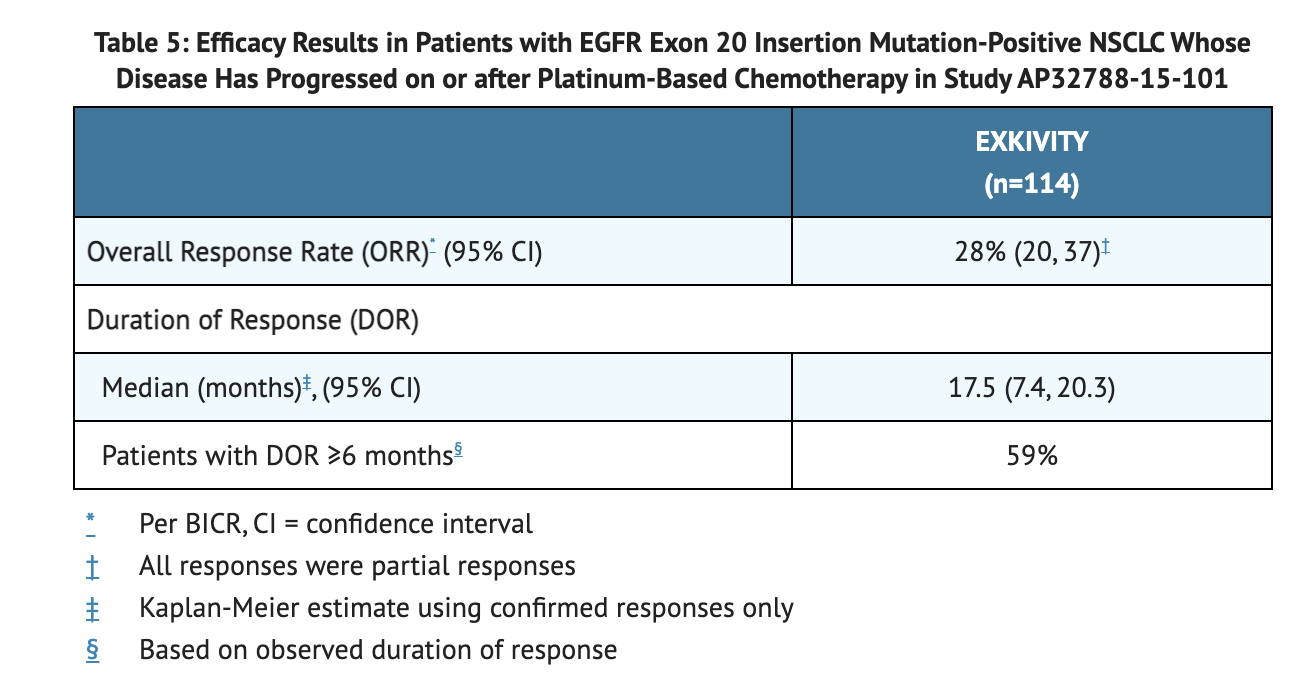
How Supplied
- 40 mg capsules dose pack (90 or 120 tablets).
- Tablets are white with each tablet being a size 2.

Storage
- Store at 20°C to 25°C (68°F to 77°F); excursions permitted to 15°C to 30°C (59°F to 86°F).
Images
Drug Images
{{#ask: Page Name::Mobocertinib |?Pill Name |?Drug Name |?Pill Ingred |?Pill Imprint |?Pill Dosage |?Pill Color |?Pill Shape |?Pill Size (mm) |?Pill Scoring |?NDC |?Drug Author |format=template |template=DrugPageImages |mainlabel=- |sort=Pill Name }}
Package and Label Display Panel
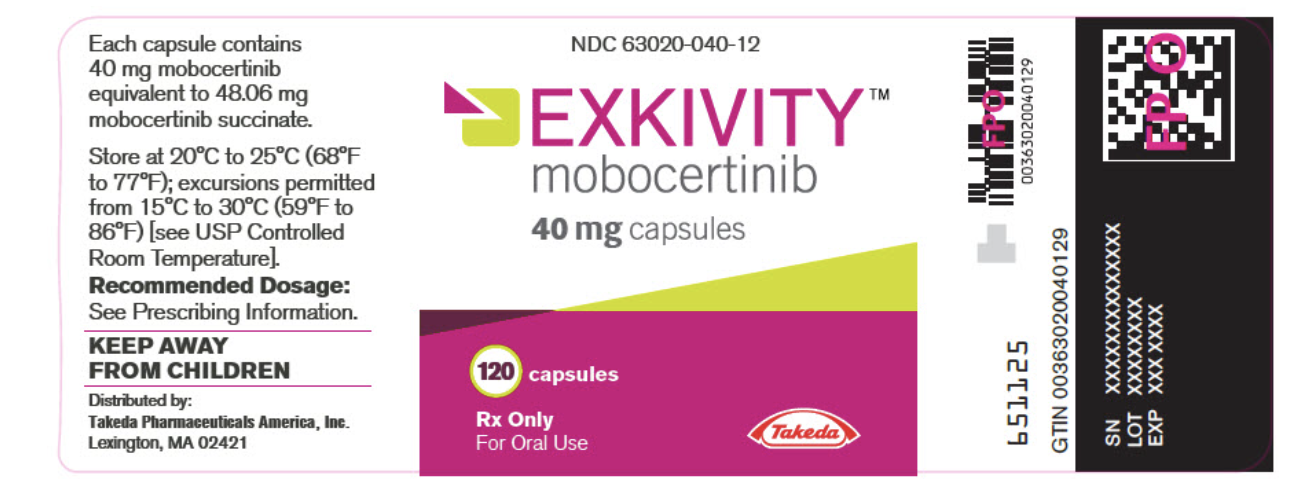
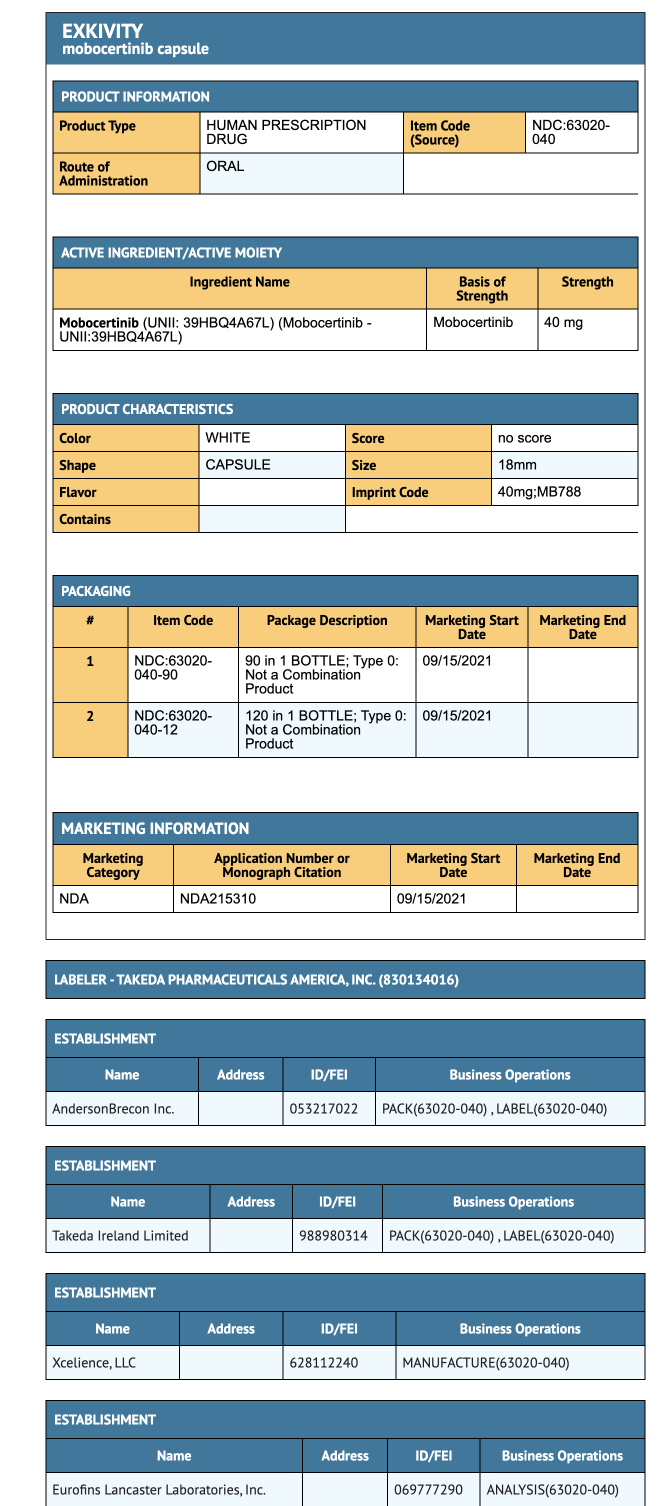

{{#ask: Label Page::Mobocertinib |?Label Name |format=template |template=DrugLabelImages |mainlabel=- |sort=Label Page }}
Patient Counseling Information
QTc Interval Prolongation and Torsades de Pointes
- Patients should be informed about the QTc prolongation risks.
- Lightheadedness, dizziness, and syncope are symptoms associated with significant QTc prolongation.
- Patients should be advised to report any signs of significant QTc prolongation to their healthcare provider.
Interstitial Lung Disease (ILD)/Pneumonitis
- Patients should be informed about the severe or fatal ILD/pneumonitis risks.
- Patients should be advised to report any signs of severe or fatal ILD/pneumonitis such as shortness of breath, cough, or chest pain to their healthcare provider.
Cardiac Toxicity
- Patients should be informed about the heart failure risks.
- Patients should be advised to report any signs of heart failure such as syncope, shortness of breath, palpitations, and chest pain to their healthcare provider.
Diarrhea
- Patients should be informed about the risk of getting diarrhea when treated with Mobocertinib.
- Patients should be advised to increase oral fluids, start antidiarrheal treatment, and increase electrolyte intake if they get diarrhea.
- Patients should be advised to report diarrhea if it continues to persist to their healthcare provider.
Embryo-Fetal Toxicity
- Advise female patients about potential risks to fetus when treated with Mobocertinib.
- Advise female patients to report any known or suspected pregnancy to their healthcare provider.
- Advise females of reproductive potential to use effective non hormonal contraception during treatment with Mobocertinib and for at least 1 month after the last dose.
- Advise males with female partners of reproductive potential to use effective contraception during treatment with Mobocertinib and for at least 1 week after the last dose.
Lactation
- Advise female patients to not lactate during and 1 week after the last dose of Mobocertinib.
Infertility
- Fertility may be impaired in both males and females when taking Mobocertinib.
Drug Interactions
- Advise patients when taking Mobocertinib to avoid drinking grapefruit juice and eating grapefruit.
- Advise patients to report any concomitant medications such as over-the-counter drugs, herbal products, vitamins, and prescription medicines to their healthcare provider.
Missed Dose
- If a dosage of Mobocertinib is missed by more than 6 hours, then skip dosage and take next dosage at scheduled time the next day.
- Do not take extra dosage of Mobocertinib if dosage taken is vomited, just take next dosage at scheduled time the next day.
Precautions with Alcohol
Alcohol-Mobocertinib interaction has not been established. Talk to your doctor about the effects of taking alcohol with this medication.
Brand Names
- Exkivity
Look-Alike Drug Names
There is limited information regarding Mobocertinib Look-Alike Drug Names in the drug label.
Drug Shortage Status
Price
References
The contents of this FDA label are provided by the National Library of Medicine.